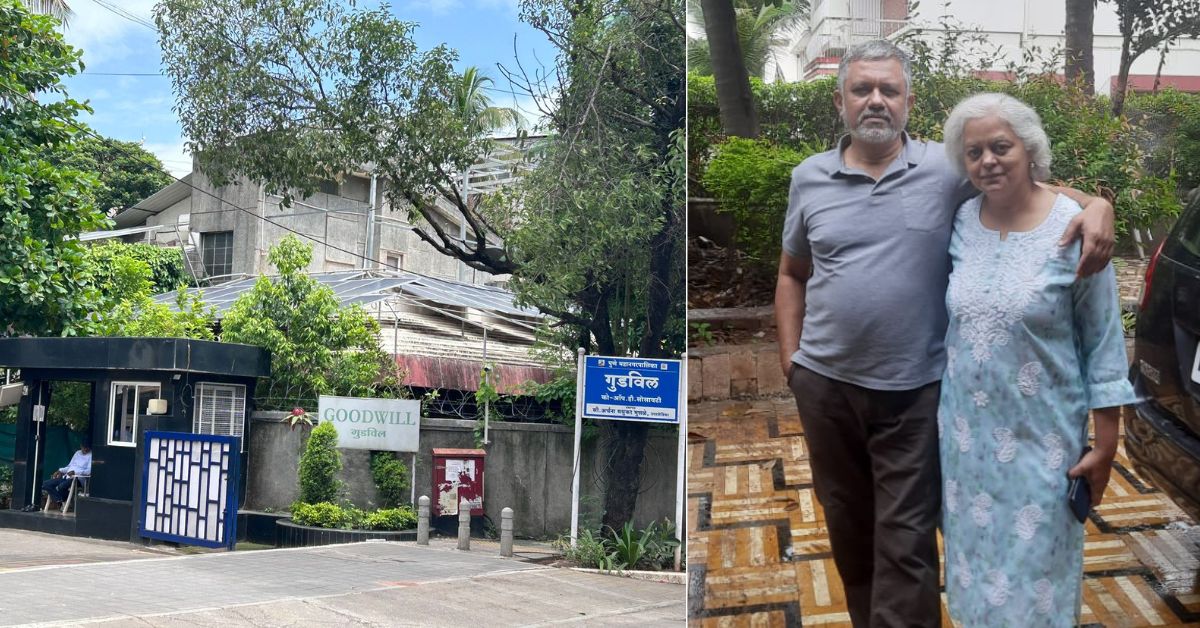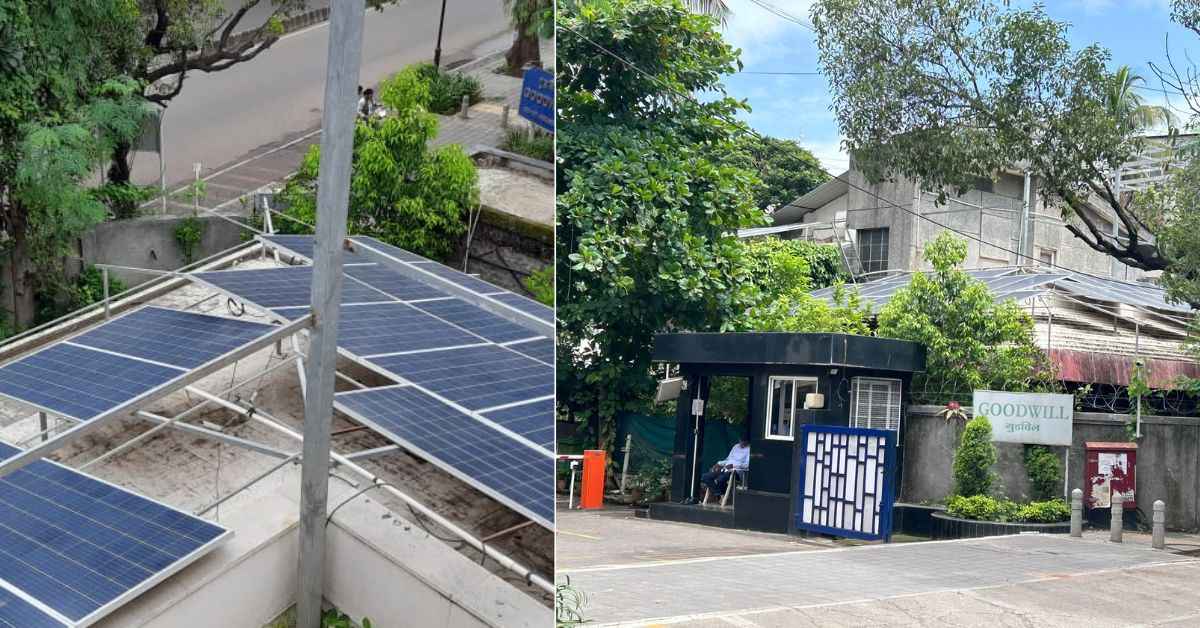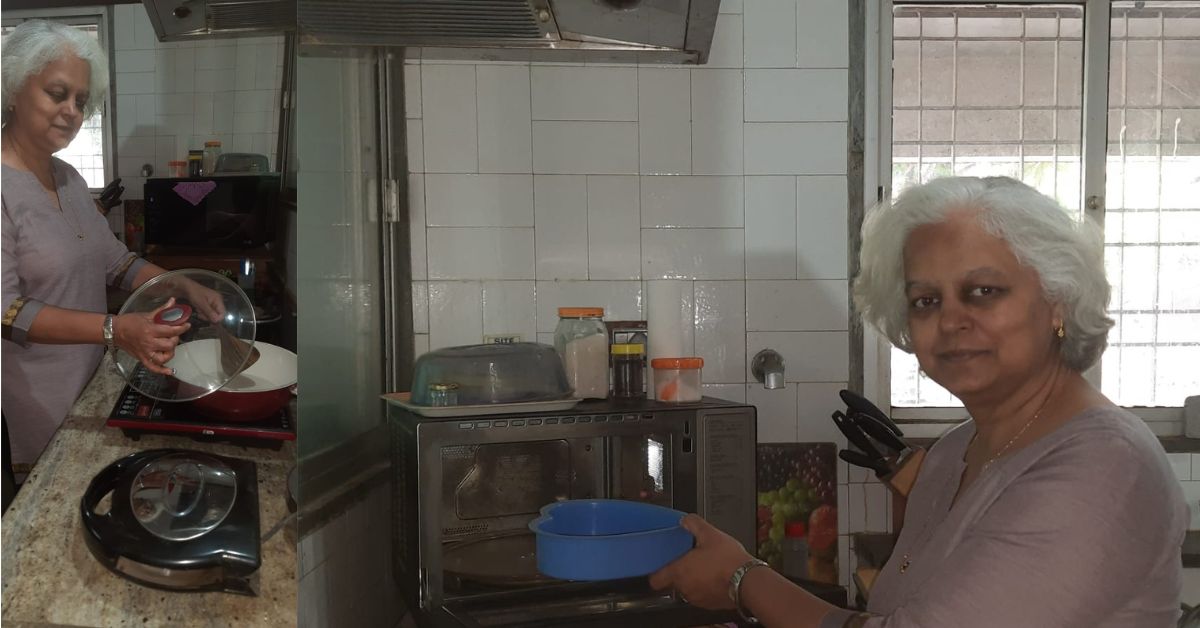Located in the serene and affluent Aundh suburb of Pune, Shilpa and Suneet Kotwal’s bungalow stands as a testament to energy self-sufficient homes.
They harness solar power not only in running the fans and lights but also with the most energy consuming and heavy appliances. From four air conditioners, washing machine, water heater to three water pumps, kitchen appliances, and even electric scooters, the couple has figured out a way to be as carbon-neutral as possible.
What’s unique about the house is that the couple planned a grid backed solar photovoltaic (PV) system in the house with a 15 kWp capacity and 20 batteries for storage.
“With storages in place, we don’t really need to compromise on our way of living. It was possible for us to continue our normal city life and live sustainably,” Shilpa shares wth The Better India.
“We don’t want to exaggerate but we have forgotten what a power outage is. We only come to know about a power shutdown when we hear the noise of a generator from the nearby hotel,” she adds.
Interestingly, the couple has brought down their power bills by 90 percent. “The power bills for our neighbours in a similar set up of the bungalow is between Rs 6,000 and Rs 10,000 per month. Whereas, we get bills between Rs 700 and Rs 1,500. Of which, about Rs 500 is the fixed component for having a metered connection. Simply put, we get a nominal power bill,” says Suneet.

Intrigued by their way of life, we sat down with the couple to know how they achieved energy self-sufficiency.
Net-metered vs grid-backed power
Shilpa and Suneet, both polymer engineers, run a solar PV installation company. In 2020, when the couple moved to their bungalow in Goodwill community, the obvious choice was to install solar panels.
“This house was constructed in 1984. After we became parents, we moved into one of the newer modern complexes where the kids could have more friend circles, better schools and amenities. Now that they are grown up, we moved back to the house,” says Shilpa.
Meanwhile Suneet, who was always interested in reducing their energy footprint and adopting sustainable manners of living, says, “My wife encouraged me to be enthused and come up with solutions where we did not compromise on our quality and standard of living. Otherwise, it would have been very easy to cut down on this and be sustainable.”
The couple decided to go off-grid. “Normally, people believe that large solar PV installations can only be done for farmhouses. We wanted to prove that we can lead sustainable lives even in the middle of a bustling city,” says Shilpa.
After moving to the bungalow, the couple installed 42 panels of 2×1 metres each, spread across 21 sq m of the terrace. While the installation took two weeks, building the whole electronics took them about eight weeks.

The whole grid-backed setfup was different from a net-metered system.
Explaining the difference between the two, Suneet says, “In the net-metered system, you do not require to store the energy and feed excess energy to the grid and get it back from it when you are not generating enough power. It is a more economical way for harnessing solar energy.”
“In the grid-backed setup, we do not feed excess power to the grid, we instead store the excess energy and use it during non-generation hours, say during the nights and cloudy days. We have our own backup. As long as I am dependent on the grid, we are responsible for coal-backed power,” he adds.
In India, the major production of electricity is achieved through coal thermal power plants which is around 75 percent of the total power generation. “If you want to reduce your carbon footprint, you need to reduce your dependence on coal and thermal energy,” he says.
“Besides, if the grid in the net-metre system decides to shut down, my house will still be in darkness even though I am generating power from solar energy. The grid-backed system helps us create power backup,” he adds.
Self-dependent on energy & water
It is to be noted that the couple has not given up on their electricity metre.

“Initially, only I was convinced about this setup, so we had to keep the grid as a backup. We have programmed the system in such a way that firstly it consumes the solar power, then it takes power from batteries during non-generation hours. If the battery ever drops, it’ll take power from the grid, which hardly happens. The entire system works seamlessly,” says Suneet.
For nearly 10 months a year, the couple claims to use zero energy from the grid. “We consume some energy from the grid for about two months in the summer when we have to run the air conditioner by the night. Sometimes, there isn’t enough generation in the day to run the AC at all hours,” he adds.
“So, we end up having Rs 1,500-Rs 2,000 bills in those months, of which the fixed metre charge is about Rs 500 to 700,” he says.
The entire setup cost the couple Rs 15 lakh and they believe they would get the return on investment within five years.
Talking about limitations of the entire grid-backed setup, Shilpa says, “Over the years, we developed a habit of running the washing machine, the mixer, water pumps only in the solar hours between 10am to 5pm or it will lead to storage exhaustion. We run four ACs in the day and only two at night. You require this kind of discipline. But these are all matters of choice.”

“Most of the city dwellers are high-energy users. These days, people are switching to electric vehicles but in reality, how much carbon footprint will they really reduce if they continue to be dependent on grid power? Families, especially affluent ones, can adopt this approach to reduce their carbon footprint while enjoying power 24×7,” adds Suneet.
Interestingly, the couple is also not dependent on the municipal water supply for their water needs.
“We already had a borewell. We took the opportunity of relying completely on ground water – from getting drinking water to watering our garden spread across 4,000 sq feet area. We also direct excess water into the ground to recharge the aquifers. One good aspect of this was that our neighbours started getting sufficient water from their borewells even in the summers,” says Suneet.
For Shilpa and Suneet, the first biggest transformation with this setup was to have an uninterrupted power supply. “And live guilt-free. We do not require additional protection from probable fluctuations and spend on voltage stabilisers. Needless to say, we don’t worry about rising power costs, which is always a topic of discussion in our social gatherings. You can bring this change as well,” says Shilpa.
Edited by Padmashree Pande. All photos: Shilpa Kotwal.
No comments:
Post a Comment